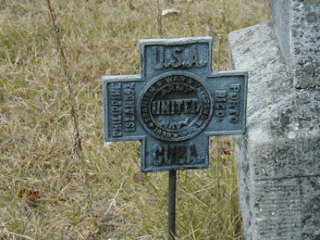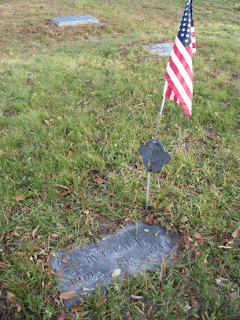While browsing our cemetery pictures to find a theme for today, I wondered from cemetery to cemetery (by pictures, not literally.) Different markers and ideas, but nothing really grabbed me. Then I remembered an idea I had been kicking around and decided it was time.
Many of the pictures we have show the flag holders and military markers that vary from war to war. Here just a few of what I've found.
This flag holder from the Everett-Big Prairie Cemetery or Community Cemetery as it is called on our index, caught my eye because of its unusual shape. I have not seen many of like this one from the Spanish American War. The name of the veteran was not included in the picture, but the marker seems to be by a large old monument. One of my Grandfather's cousins also fought in this war, although he died in World War I. I haven't found his grave, but I presume he would have the World War I marker.
The above marker and the one below were from two different years on my Great Uncle Bert's grave. The above one is in a common star shape and says veteran. Below you can see one that says American Legion on it.
The stone on Uncle Bert's grave is the military marker that was typical of military stones, and it gives his rank, and the unit he was in: Co G 64 Infantry, World War I. His wife was the Aunt Lyla that my dad made a stone for. They are found in Clark Cemetery, west of Fremont.
My Great Great Grandpa Armenus was my first discovery in doing my genealogy when I found him in the Michigan 1890 Veterans Census Index. My thrill at connecting with him was dimmed by his flush stone that regularly needs to be dug out and made visible again. Above and below are his military flagholder, showing him to be a member of the Grand Army of the Republic.
The holder is in great condition. GGGramps is in Hawkins Road Cemetery, just north of Newaygo County, in Lake County.
As is this stone and marker found in the East Hesperia cemetery. The flag holder is also GAR. I suspect that the worn marble slab may be a military stone.
Last of all are these: the flag holder and plaque marker for my Grampa's younger cousin, Paul Davis. He grew up with my Great-Granddad who was his uncle/stepfather. I was forever finding information on him because he enlisted under my GGranddad's surname, rather than his own, as a tribute for being raised by him. While I neglected to turn the flag holder around to see the front it when taking the picture, you can see shape is different than the previously shown holders. The bronze marker, the kind now used rather than marble, I find unique because it only has his first name. Perhaps the confusion caused by his enlisting as a Gilbert, while his family name was Davis is the reason. I have found the news articles from when his body was brought back from France after the war so even though he died in France, he is interred here.
Cousin Paul is also in the same cemetery as my GGGrandpa Armenus, just outside the county. I often stop and hello to both, assuming I can find Armenus's grave.







Update on Cousin Paul's stone. After checking several other pictures, I think his stone is granite, and not the bronze I thought I remembered. Nowadays you often find the bronzed military markers fixed to back of the regular markers.
ReplyDelete